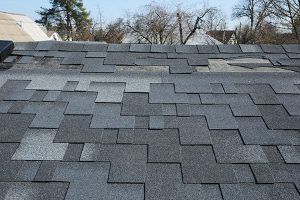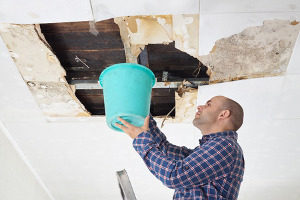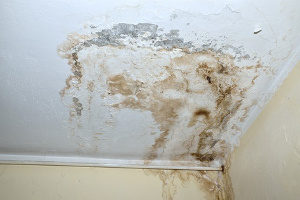 A damaged roof, or one that was improperly installed, or one that is just worn out, may be leaking. Neglecting your roof could be one big mistake.
A damaged roof, or one that was improperly installed, or one that is just worn out, may be leaking. Neglecting your roof could be one big mistake.
When water comes in through your roof, it can travel down the roof joists, behind the walls, along ductwork, and down electrical pathways. You may just notice a ceiling stain or a bubble, or peeling paint that you cannot explain. Or, you may notice wet spots on personal items stored in the attic. If you do see water, it could be just be a little dribble along the attic ceiling. You could see water dripping from one of your ceiling light fixtures, ceiling fans, or HVAC ceiling vents. These are signs you may have a leak in your roof.
You know that you should have a professional look at it, but you procrastinate because you are busy or funds are tight. So you decide to let it go awhile. Or, perhaps your roof is leaking but you know nothing about it because you see no visible signs. You may not become aware of it until the leak has caused significant damage. Over time, what once was a small leak can lead to a very expensive roof repair. In most cases, having a professional roofing contractor inspect your roof before a leak becomes noticeable could have detected and repaired it before the leak becomes dangerous and a major roof repair expense.
Here are four of the dangers your leaky roof can cause that you may not have considered:
Structural Damage
 Over a short period of time, roof leaking can cause serious damage to the drywall, electrical fixtures, insulation, and even rot the wooden ceiling joists and framework in your ceilings and walls. Once the structural integrity of these items is compromised, you will face significant repair bills.
Over a short period of time, roof leaking can cause serious damage to the drywall, electrical fixtures, insulation, and even rot the wooden ceiling joists and framework in your ceilings and walls. Once the structural integrity of these items is compromised, you will face significant repair bills.
Injury to Family and Friends
A roof that leaks heavily enough can create puddling on your floor. A puddle on the floor is a slip and fall hazard to family members and friends, especially treacherous for children and seniors. Also, your ceiling can become so heavy with water that the drywall or plaster collapses. It can injure anyone underneath and damage carpeting, furniture, and other personal property. Your insurance may or may not protect you against all of the damage and costs of a roof repair.
Fire
Have you considered that a leaking roof can present a fire hazard? If the water comes into contact with faulty wiring in your attic or elsewhere, it can trigger a fire. At the very least, water in the wiring leads to aggravating chronic issues with GFIs and circuit breakers.
Mold
 Mold is one of the worst consequences of a leaking roof over the longer term. Mold and mildew in the home can affect your health. According to the U.S. Environmental Protection Agency, mold and mildew can cause severe allergy symptoms, asthma, and other maladies. Some people are very sensitive to mold. For them, mold presents a very serious health risk.
Mold is one of the worst consequences of a leaking roof over the longer term. Mold and mildew in the home can affect your health. According to the U.S. Environmental Protection Agency, mold and mildew can cause severe allergy symptoms, asthma, and other maladies. Some people are very sensitive to mold. For them, mold presents a very serious health risk.
Mold will grow and spread through the HVAC system and throughout the house. It is difficult and very costly to eliminate.
How Can You Protect Against These Dangers?
It is not unusual for a homeowner to be completely unaware that the roof is leaking. The best way to protect yourself and your property is to develop your own preventative roof maintenance program. Get a licensed professional roof repair contractor or inspector to conduct a visual inspection and do routine maintenance on an annual basis. A pro knows just what to look for and has the right tools to help detect leaks.
A professional inspector should conduct an examination of the roof exterior. The inspector will walk on your roof to look for soft spots which indicate the presence of mold or rot. Loose and missing shingles, along with shingles that are worn, dented, cracked or are rotting, will be noted. Also, the inspector will make sure the flashing is properly attached and installed in the right places to prevent leaks and repel water and ice. If you have a chimney, the inspector will make sure it presents no structural hazards. Similarly, the inspector will make sure the gutters are properly secured and operating.
The inspector will also check the interior. From the interior, it is easy for the inspector to detect leaks. Usually, the inspector will observe water marks and smell moisture. Evidence of the presence of pests, such as nests, shredded insulation, hollowed wood, or hives, will be evaluated to determine if these could be the cause of a leak.
The inspector will likely note any other issues that need to be addressed along with a quote for a needed roof repair. Feel free to get a second opinion if you are not comfortable with the inspector’s findings.
The cost of such an inspection today is a good investment in maintaining a sound roof and avoiding costly repairs later.